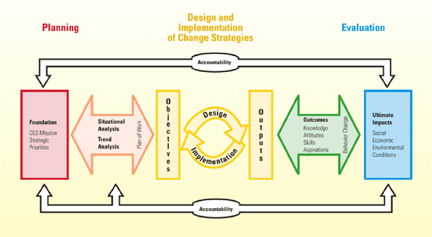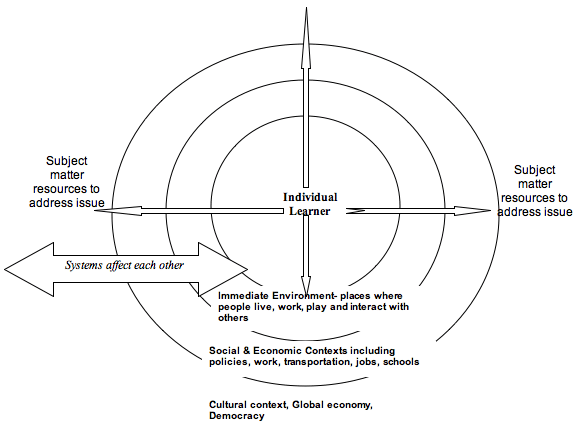October 2007 // Volume 45 // Number 5 // Commentary // 5COM1
How Integrated Extension Programming Helps Market Cooperative Extension: The North Carolina Recommendation
Abstract
In a contemporary society, Extension educational programming must consider the multiple community systems affected by identified issues. Recommendations based on a 2-year study process in North Carolina demonstrate how integrated educational programming is connected to marketing Extension. Two figures provide a visual of the concepts described.
Do you ever get tired of people saying, "Extension seems to be the best kept secret?" Those of us who have described our work to others have heard this time and again. Cooperative Extension is indeed a wonderful network of professionals delivering educational information on a variety of topics to the public. However, to truly market what we do, we must take a long hard look at our organization and assure that we are meeting the contemporary needs of society.
Marketing the organization is intricately linked to how we conduct our day-to-day business. It is not simply about a new logo or an updated brochure. Marketing goes to the core of who we are and how we operate.
Taking a Close Look at Ourselves
To market what we do best, we must first recognize what it is that we do best. Cooperative Extension in North Carolina set out to identify and preserve the best of our rich Extension past while looking toward a renewed future. Establishing a renewed identity parallels the vision referred to as "Engaged Universities" presented the Kellogg Commission (2001).
In their report, 25 university presidents collectively agreed that land-grant universities must be responsive and relevant by "bringing the resources and expertise at our institutions to bear on problems in a coherent way." Further, they indicate that within the university, the lines between disciplines must be more transparent, and faculty must be more involved with community issues. The concept of the "engaged" university is valuable in guiding the analysis of the Extension organization and how the organizational structure of Extension parlays into marketing difficulty.
Analyzing Extension's Organizational Structure
Analyzing Extension's organizational structure involves understanding internal relationships, relationship dependency, and how authority is granted and managed. In empowered, credible organizations, Tjosvold (1991) recommends establishing strong cooperative links and constructive relations in organizations by developing: (a) a common direction and vision, (b) mutual tasks, (c) assessment of joint productivity, (d) shared rewards contingent upon success, (e) complementary responsibilities and roles that require collaboration, and (f) team identity and supportive culture (p. 297). These are primarily structural and cultural interventions aimed at fostering interdependent (rather than dependent) relations within the organization. That is, less dependency and more shared autonomy.
In taking a long hard look at Cooperative Extension, it is apparent that there are many dependent units within Extension. Externally, Extension is no longer in a safe cocoon of county and state government. Others have become part of our traditional and comfortable arena. Over time, these transformations within community organizations have caused Extension to respond in an often undisciplined, segmented, disjointed fashion. How then can an organization be marketed that has so many aspects and that is serving so many areas? It is difficult for the public to understand and grasp.
What Part of Extension Should Be Marketed?
In his book From Good to Great (2001), Jim Collins advises organizations to identify "their passion, what drives them economically, and what they can be best in the world at" (this author paid no heed to ending a sentence in a preposition). The meeting of these three aspects becomes the (marketable) vortex that represents Extension work. For Extension, this can become the litmus test for decisions regarding planning, prioritization, programming, marketing, personnel functions, and accountability.
A North Carolina Extension study team identified Extension's passion as enhancement of the quality of people's lives (economically, environmentally, etc). This includes all people, all classes, all races, all backgrounds. The second aspect, what drive Extension economically, is Extension-built internal and external networks (county partnerships, foundations, grants, and other opportunities). And finally, what is Extension best in the world at? The team agreed that Extension has the ability to provide a collective application of a vast network or portfolio of resources.
By combining the Collins vortex with the vision of an engaged university, the North Carolina study team realized program prioritization, program development, and marketing are intricately linked organizational functions. Traditionally, Extension has viewed marketing as merely promotion. This view places Extension communications units in a reactive role. Thus, the team recommended that an integrated educational programming response organizationally must be coupled with marketing efforts in the initial stages.
Revising the Extension Educational Model
If the marketable vortex involves an internal and external application of the portfolio of Extension resources to enhance lives, then the first step in strengthening marketing is to revisit the educational programming model. The educational programming model serves as the underpinning by which new educators are oriented and experienced educators retrained, and provides the bridge to connect marketing with educational programming. Extension educators in North Carolina worked for more than a year to gain system agreement on the new model and definitions. Figure 1 depicts the new model.
Figure 1.
North Carolina Cooperative
Extension Program Development System

The definition of educational programming has theoretically (Boone, Safrit, & Jones, 2002) been available but the knowledge of HOW to conduct educational programs is often short-cut, with anxious public servants jumping into educational intervention as opposed to giving attention to the critical steps of intentional planning. The revised North Carolina Extension educational programming definition is: that educational programming "is a planned, comprehensive, and integrated set of educational change strategies that are based on documented, high priority needs and are designed to produce behavioral changes among targeted learners that filter throughout social systems to produce social, economic and environmental impacts" (Guion, 2007).
Nested within this definition is a key component that makes this approach different--integrated programming. Integrated programming positions Extension operating as "engaged" with communities around issues as opposed to operating in rigid or narrow subject matter areas. Integrated programming is defined as a collaborative approach involving partners and various disciplines planning and implementing one or more strategies to impact micro and macro systems associated with one or more identified issues (DeBord, 2007). Issues programming has been part of Extension as a system for decades. An issue is a matter of widespread public concern. It is complex and multifaceted, and requires multiple disciplines to bring about impact.
Integrated Programming
Integrated programming has two critical dimensions. First, it requires multiple disciplines to bring resources to bear on the identified issue, and second it goes deep within economic, community, and social systems. In the definition of integrated programming above, "systems" refers to places and organizations where people interact, such as schools, families, organizations, government, economy, and culture (Bronfenbrenner, 1979).
Learners are the smallest (or micro) aspect of the social system. However, a macro system refers to impacts made with community organizations, systems, policies, standards, or rules, including culture and the economy. In order to truly create change, we must not only work collaboratively across disciplines but we must address the issue at various social levels. Figure 2 provides a visual diagram.
Figure 2.
Integrated Programming Model to
Address Community Issues Must Use Multiple Resources and Work Across
All Societal Systems.

Examples of Integrated Programming
To illustrate integrated programming, imagine an Extension educator who is teaching an individual how to prepare for the workforce by teaching job interviewing skills, job-related skills, and resume building. While those are valuable skills to have, integrated programming would see beyond the individual to the other systems that touch this issue of economic development. If, within that community, there are few jobs, there is not transportation for the individual to use to get to work, and no child care for that worker, then what good has it done to teach the individual? An impact has to be made in other system levels and additional partners must be part of the educational design team.
Another example is the emerging issue of urbanization or uncontrolled growth in communities. This issue affects the environment, the economy, and quality of life. Multiple strategies are needed at the homeowner level (landscape practice), the youth level (understanding the environment), the family level (creating connections between parent/ child/grandparent to partake of and understand the environment), as well as the community policy level (zoning, growth policy, infrastructure). These are just a few of the partners that must be mobilized to anticipate a collective impact while bringing multiple Extension resources to bear on the issue.
Tying Marketing and Program Development Together
In North Carolina, we envision a long process to organizationally change who we are and how we operate. One marketing firm (Carolina Public Relations) indicated that once we are ready organizationally, we will "earn" our logo, and marketing will fall into place. To strategically prepare for marketing, NC Cooperative Extension has made some organizational changes. The first step was identifying three strategic priorities: environment, economy, and youth/family/ community well-being. Issues flow from these priorities areas.
New specialists in both program development and marketing have been hired to work closely together to identify multi-system and multidisciplinary efforts that address the priority areas. The marketing specialists will highlight those efforts that are truly integrated and that affect systems within the strategic priority areas. However, marketing will be incorporated at the beginning of the educational process and all along the way, not just at the end.
Only time will tell if these initial organizational changes will affect the way Extension is perceived by the public. However, the renewed sense of addressing contemporary societal issues has given a facelift to an organization ever interested in providing educational intervention to meet public needs.
References:
Boone, E. J., Safrit, R. D., & Jones, J. (2002). Developing programs in adult education, 2nd Edition. Prospect Heights, IL: Waveland.
Bronfenbrenner, U. (1979). The ecology of human development: Experiments by nature and design. Cambridge, Mass.: Harvard University Press.
Collins, J. (2001). From good to great. New York: Harper Collins
DeBord, K. (2007). North Carolina Extension Conference. North Carolina State University. Raleigh, NC.
Gabelnick, F. MacGregor, J. Matthes, R. S. & Smither, B. L., Eds. (1990). Learning communities: Creating connections among students, faculty and disciplines. New Directions for Teaching and Learning. No 41. San Francisco:Jossey Bass.
Guion, L. (2007). North Carolina Extension Conference. North Carolina State University, Raleigh, NC
Holland, B. (2005). Civic and academic engagement in the multiversity
Institutional trends and initiatives at the University of California. Symposium presentation. Berkeley, CA. Retrieved January 29, 2007, from: http://cshe.berkeley.edu/events/seru21symposium2005/
Kellogg Commission (2001). Returning to our roots: Executive summaries of the reports of the Kellogg Commission the Future of State and Land Grant Universities. Retrieved June 2007 from: http://www.nasulgc.org/Kellog/kellog.htm
Tjosvold, D. Andrews, I. R., & Struthers, J. T. (1991). Power and interdependence in workgroups. Group and Organizational Studies, 16 (3). 285-299.
Witkin, B. R., & Altschuld, J. W. (1995). Planning and conducting needs assessments: A practical guide. Thousand Oaks: Sage Publications.
